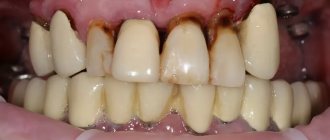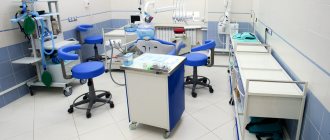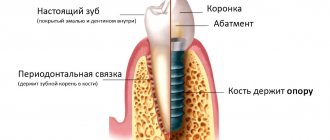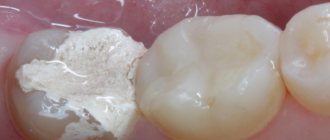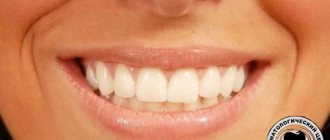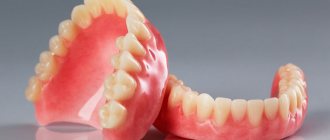Dental prosthetics on implants is the most reliable and productive way to restore the integrity and performance of the dentition in case of partial or total edentia. The essence of the technique is to install a prosthetic product on artificial roots made of high-quality titanium implanted into bone tissue.
Among all existing types of replacement of lost teeth, this technology is the most gentle and cost-effective. A correctly installed and established implant has an unlimited service life, making it possible to fully restore the functionality and aesthetics of teeth.
If you are looking for where to undergo dental prosthetics on implants in Moscow, the SDent dental center offers professional and affordable services. Our clinic employs highly qualified doctors and has the latest material and technical equipment. We use high-quality implants. All procedures are carried out with a quality guarantee.
Prices for dental prosthetics on implants
| Name of service | price, rub. |
| Metal-ceramic crown (KHS) supported by an implant | from 27700 |
| Ceramic crown on a zirconium oxide frame supported by an implant | from 45900 |
| Making a temporary crown supported by an implant | from 5900 |
Make an appointment with an implantologist
Technology of dental prosthetics on implants
At the SDent clinic you will be offered safe and reliable prosthetics using implants. Replacement of lost teeth is carried out using various orthopedic structures:
- fixed dental prosthetics on implants. Depending on the number of units to be restored, the patient is provided with bridges or single dental crowns. The artificial root itself is integrated for life; the service life of the prosthesis, subject to the rules of care, is at least 10-15 years;
- removable dentures. It is usually used for complete edentia. The prosthesis is firmly fixed with beam-type locks or buttons, and the patient can independently remove it at night or for hygiene procedures;
- conditionally removable dental prosthetics on implants. The prosthesis is secured with screws; the patient cannot remove the device without the help of a doctor. Most often used when all teeth are missing. The most popular methods of dentures are All-on-4 according to the “all on four” concept and All-on-6 according to the “all on six” principle.
The prosthesis can also be fixed on two metal roots or mini-implants, but with complete dentures such options are rarely used, since the risk of fracture of the orthopedic structure is very high.
According to their purpose, all prostheses are divided into temporary and permanent. Temporary or adaptation ones are installed for a period of 6 months to 3-4 years immediately after implantation of the artificial root; the teeth themselves are made of plastic. Permanent products are made from composite materials; dentures are carried out after the implants have completely healed.
The price of dentures for teeth on implants is calculated personally for each individual client of the clinic and depends on the material used and the type of product.
Free consultation
Our specialists will conduct a free consultation and select the best treatment option for you.
Sign up now! Online registration
+7 (495) 649-41-19
Content
1 Fixed dentures: main characteristics 1.1 In what cases are fixed dentures installed in Moscow?
1.2 Pros and cons
2 Types of fixed dentures 2.1 Features of the use of veneers
2.2 When is the best time to use tabs?
2.3 Crowns per tooth
2.4 Features of installation of bridge structures
2.5 Fixed denture on implants
3 How to care for fixed dentures? 3.1 What hygiene procedures must be observed?
3.2 What special means must be used?
Prosthetics on 4 implants using All-on-4 technology
The All-on-4 method is dental prosthetics on implants with immediate loading. Its essence consists of introducing four dental implants into the jaw, two of which are placed in a vertical position in the front part of the jaw, and the remaining two in the lateral zone with an angle of up to 45°. Each titanium rod consists of an apex (abutment) and a part that is implanted into the bone tissue.
The popularity of the technology is due to the following advantages:
- Immediately after implantation, you can use the “new” teeth, gradually increasing the load. After 2-3 weeks, chewing function is completely restored;
- Thanks to the non-invasive installation, there is no need to perform bone grafting, sinus lifting and other manipulations to restore bone deficiency.
The price of dental prosthetics on implants using the All-on-4 method is higher than traditional methods, but the long-lasting results and aesthetics of the structures fully compensate for such costs.
The technique is ideal for those who have partially or completely missing teeth, have a lack of bone tissue and it is impossible to build it up for specific reasons, as well as for patients who prefer reliable and safe methods of prosthetics.
Along with its high efficiency and uniqueness, the technology is not suitable for everyone. If a patient’s jaw bone is severely atrophied, then doctors recommend alternative methods of teeth restoration.
Types of fixed dentures
The use of a particular dental product depends on the degree of destruction of natural crowns. Below we will tell you what types of fixed dentures are and look at the cases in which they are used:
- Veneers: with minor destruction of the surface of the dental unit;
- Inlays and crowns: for total damage;
- Bridge structures: with a lack of one or more dental units;
Implants: in case of complete absence of teeth.
Features of using veneers
Veneers are small plates up to 0.5 mm thick. Reasons for installing such microprostheses include minor areas of damage on the tooth surface: dark spots, chips, scratches, the presence of an unnatural gap between dental units, etc.
Today, ceramic plates are mainly used, since they have a greater aesthetic value and are considered more resistant to wear than composite ones.
Currently, you can find ultra-thin veneers made of ceramic or porcelain (no more than 0.2 mm). They are produced using a special technology, which uses an adhesive containing fluoride, which has a beneficial effect on teeth. It is possible to install such a fixed denture in one day, but this procedure requires the participation of a highly qualified specialist with extensive experience in the field of prosthetics.
Read more >
| Service | Price, ₽. |
| Examination of the patient, calculation of the cost of services | for free |
| Ceramic veneer | 22 000 |
| Aesthetic restoration of anterior teeth according to class III | 3500 |
| Aesthetic restoration of anterior teeth according to class IV | 3800 |
When is the best time to use tabs?
Inlays allow you to eliminate large carious formations that cannot be treated with a conventional filling. As a rule, such microprostheses are used on chewing dental units. If the tooth is completely destroyed, but its root part remains, a stump support is initially installed, which is subsequently used to fix a bridge structure or a single prosthesis.
The following tab options are available:
- Made from pressed ceramic. They are distinguished by impeccable aesthetic indicators, have a precise design and are famous for their extremely high strength. The only drawback that such fixed dentures have is considered to be overpriced in Moscow;
- Metal. They contain an alloy that is durable and reliable in operation. Negative aspects include lack of aesthetics. Can be used as supporting elements for the purpose of subsequent fixation of a bridge or single prosthesis;
- Porcelain. They have excellent aesthetic parameters, but are among the least durable microprostheses.
You can also find a fixed metal-ceramic dental prosthesis, the strength of which is not inferior to its aesthetic characteristics. The only negative point is the high risk of loss due to the discrepancy between the expansion indicators of ceramic and metal materials.
Ceramic inlay Oh Lay, In Lay, Over Lay — 19,000 ₽ Inlays made of silver-palladium alloy (excluding metal cost) — 9,850 ₽
Read more >
Prosthetics on 6 implants using All-on-6 technology
The principle of this technology is based on the All-on-4 concept, only six titanium rods are implanted into the jaw instead of four. Two additional rods are installed in the frontal section.
Such implantation is used for moderate bone atrophy, as well as for an increased risk of rejection of the titanium structure.
Dental prosthetics with All-on-6 implants is possible for severe forms of periodontitis and periodontal disease.
Dentures are installed for a period of six months to 4 years, after which the products are replaced with more durable options that can last up to 2 years with proper care.
Stages of dentures on implants
Regardless of the type of prosthesis installed, as well as whether prosthetics is performed on implants in the absence of complete or partial teeth, the procedures are carried out in the same order and in stages.
Preparatory stage
First, the implant surgeon conducts a thorough examination of the patient’s oral cavity and refers him to diagnostic measures. Based on the results of X-rays, computed tomography and orthopantomogram, the volume and condition of bone tissue is assessed.
If necessary, the patient is additionally examined by a therapist and an orthopedist, and is sent for laboratory tests.
A mandatory procedure is also sanitation of the oral cavity, which includes professional cleaning, removal of roots and teeth that cannot be treated, and treatment of caries.
Surgical stage
Pain relief is carried out with powerful local anesthetics and lasts an average of 30-60 minutes. In classic dentures, the doctor makes an incision in the gum, uses special burs to form a bone bed, places a titanium root in it and applies sutures. After 7-10 days have passed after implantation, the sutures are removed.
With minimally invasive technology, a small puncture is made in the gum and the rod is carefully screwed deep into the bone. When screwed in, the bone is compacted, which ensures reliable and durable fixation of the implant.
If the volume of bone tissue is not enough, then it is increased with special synthetic materials.
Orthopedic stage
Temporary orthopedic devices are installed no earlier than a week after the implantation is performed. Permanent prosthetics are carried out only after 4-6 months, when the metal roots have completely taken root.
Dental prosthetics on implants using All-on technology on four or six provides for the immediate installation of temporary dentures. Immediate loading significantly accelerates the healing of artificial roots and significantly improves the aesthetics of the smile.
The manufacture of an orthopedic device is carried out in the following order:
- taking impressions from the jaw and determining the bite;
- making a template, wax base and metal base;
- fitting of the design;
- selection of material and color of the future prosthesis, veneering;
- installation of a prosthesis.
Taking into account the preparation for the operation, the implantation process and the healing time of the prosthesis can be extended up to 3 months. When implanting with immediate loading, the procedure is carried out in one stage and quickly returns the functionality of the dentition and a beautiful smile to the patient.
Gum contour.
A very important point in implant prosthetics is maintaining the gum contour. If an inexperienced implant surgeon misses this point, then the patient’s dissatisfaction may begin to express itself due to aesthetic complaints: the gums around the implant are blue, there are no gingival papillae, and they play a big role in the aesthetic component. To the point that over time (can happen in a very short time) the patient develops a problem with gum loss (gingival recession) and exposure of the implant neck. In our Es-Dent dental center, according to indications, close attention is paid to gum plastic surgery. If an implantologist says that a procedure with the gums is necessary, you should not ignore this stage of treatment in order to avoid problems after the installation of the prosthesis.
Why there are problems with gums.
- A person may naturally have thin gums. Its ideal thickness is 5 millimeters. If the patient’s skin is twice as thin, then one can definitely expect poor-quality aesthetics after prosthetics (if appropriate therapeutic measures are not taken). This will be, at a minimum, unsightly, and at maximum, it will lead to exposure of the implant.
- Attached gum. There may be a deficiency of this type of gum. Ideally, the gums should grow tightly together with the periosteum - this is the attached gum. But the second type is mobile. The results of ignoring gum surgery are the same as with the thin biotype.
The graft for gum plastic surgery is taken from the patient himself in certain places in the palatal space.
Advantages of prosthetics on implants
Along with the fact that the cost of dentures on implants is not the lowest, this technique is very popular. This is explained by the following advantages:
- Using dental implants, pathologies of any extent in the lower and upper jaw row can be eliminated;
- artificial roots stop the process of deformation and bone loss in the segment of the missing tooth;
- When installing a prosthesis, adjacent teeth are not ground down, which protects them from loosening and destruction;
- dental implants are able to withstand high loads without loss of strength, which contributes to the durability of prosthetic structures;
- implants are a complete replacement of natural teeth and therefore do not cause discomfort;
- With single-stage implantation, lost units in the dentition can be replenished immediately after their removal, which makes it possible to quickly restore the chewing and aesthetic functions of the teeth.
A wide variety of types of dental implants allows us to select suitable prosthetic devices for each patient and carry out restoration of the dental system at a high level of quality.
Functional diagnostics for occlusion restoration
Determination of the closure horizon and jaw relationship using a facebow and articulator SAM3, Protar or Amann Girrbach.
- Allows you to find and measure the parameters of future teeth, their relationship with the opposite row
- The data obtained is used to create a model of the prosthesis, select the number and position of implants
Indications for prosthetics on implants
Many patient problems can be solved by dentures on implants. The procedure is indicated for:
- included single defects, when there are intact units on both sides of the lost tooth;
- problems of a local nature, in which several dental units are missing in a row;
- end defects. If the last teeth in a row are lost, then in most cases they can only be restored with the help of implants;
- complete loss of teeth. When a patient has increased sensitivity to acrylates and does not want to install removable structures, then dental prosthetics on implants will help solve the problem.
In our clinic, everyone can count on qualified assistance, individual selection of designs and reasonable prices for all services provided.
Abutment selection.
They vary in type of manufacture and in the materials from which they are made. If you decide on the choice of a metal-ceramic crown, then a titanium abutment is quite suitable. If the crown is made without metal, from zirconium dioxide, then there are no options, only a zirconium abutment.
Regarding the question: standard or custom? Their cost varies, but not critically (individual is a little more expensive). BUT, the individual abutment is made with the utmost precision for the crown to fit to it, microgaps are eliminated, and pathogenic microbes will not enter the implant area. In the case of a standard one, there is a high probability that cement will get into the implant area already at the stage of fixing the crown, and subsequently microbes and bacteria will enter the implant area.
Contraindications to implant prosthetics
Like any dental procedure, dental prosthetics on implants has certain contraindications.
Installation of artificial titanium roots is not carried out if:
- poor blood clotting;
- tuberculosis and HIV infection;
- diabetes mellitus;
- severe disorders of the nervous system;
- the presence of malignant tumors;
- liver and kidney failure;
- diseases of bone and connective tissue.
There are also general restrictions:
- exhaustion of the body;
- depressive and stressful conditions;
- hypertension and other pathologies of the cardiovascular system;
- general infectious pathologies.
Inflammation of the gums and tissues, caries, bone tissue atrophy, pregnancy and breastfeeding are relative contraindications and after their elimination, implantation can be performed.
Implant care rules
To ensure that dental prosthetics on implants does not cause complications, and the structures themselves last as long as possible, you should adhere to the following recommendations:
- do not load artificial roots for the first 3-4 days after their installation, and do not eat solid food for at least a week;
- use dental floss to clean structures and special antiseptic rinsing solutions. Once the gums have healed, you can brush them with a toothbrush;
- avoid hypothermia and intense physical exertion for 10-15 days after surgery, as well as stop or limit smoking to a minimum, and do not drink alcoholic beverages;
- In the first days after implantation, you need to sleep on several pillows so that your head is as high as possible.
You also need to periodically visit your doctor for preventive examinations. If necessary, the doctor will correct the gums, clean the tooth surface from subgingival and supragingival deposits, advise on how to prevent the accumulation of plaque and give other necessary recommendations.

